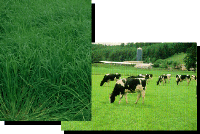"Of all plants, the grasses are the most important to man. All our breadstuffs - corn, wheat, oats, rye, barley - and rice and sugarcane are grasses." (Chase, 1948)
Grasses occupy all parts of the earth and exceed any other (plant) in the number of individuals. They reach the limits of vegetation (except for lichens and algae) in the polar regions and on mountaintops. They endure both cold and torrid desert conditions, form the main part of the vegetation of vast prairies, plains, savannas, and steppes of both hemispheres, and occupy great stretches of marsh and tidal flats, where they are building up the land.
The importance of the grass family should not be overlooked or underestimated. Instead, the variety of grasses should be recognized and appreciated. From the grasses in our lawns and parks, to the meadows and pastures, to the large bamboos in forests, the grasses can boast a diverse family tree which provides many benefits to mankind.
How much would it cost to purchase an equivalent amount of protein and energy provided by an acre of good pasture? Alternative feed stuffs might include high-quality hay or silage; a protein supplement; and digestible energy in the form of feed grains.
How much protein and energy should you expect from an acre of good pasture? The target amounts will vary with forage species, soil fertility, growing conditions, and many other factors but many growers expect at least 5 tons of dry matter per acre. How much protein would you find in 5 tons of dry matter consumed as pasturage?

But protein is just one of the products you find in a good pasture. The energy in the form of fiber and carbohydrates is equally important. Assuming that the dry matter in 5 tons of pasturage is 60 percent digestible; we would have 6000 lbs. of digestible dry matter. That is a sizeable package of energy. Assuming that feed grains are 80% digestible, the energy in the pasture equates to 7500 lbs. of grain (130 bushels of corn).